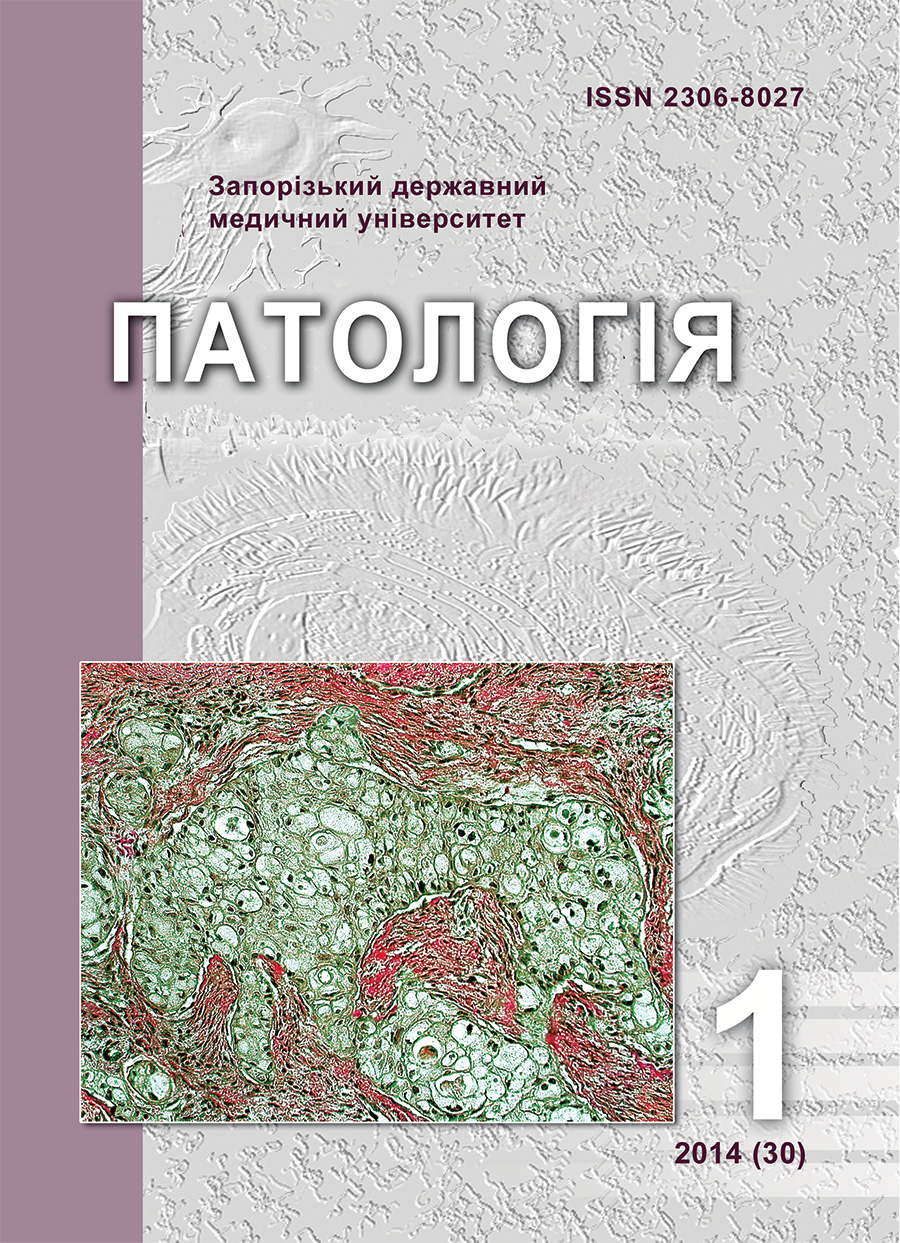Experience of usage of forming rings and protective caps made of PTFE on the single-component implants
DOI:
https://doi.org/10.14739/2310-1237.2014.1.25960Keywords:
blade implantation, PTFE, dental implantsAbstract
Relevance. The main reason that limits the usage of single-component implants, as compared with collapsible (two-component) implants is the high risk of infectious and inflammatory complications in the postoperative period and problems in prosthetics in the esthetically important areas. Therefore, the usage of elements that contribute to healing of the mucous membrane in the early stages of implantation is particularly up-to-date.
Work objective is to determine the clinical effectiveness of usage of forming rings and protective caps made of PTFE on the single-component implants in the prevention of peri-implant pathology on a one-step surgical implantation.
Materials and methods of the investigation. For this work we used the treatment results of 24 patients with various dentition defects. According to the single-component implant procedure 52 single-component implants were mounted. The head of monolithic implants (38 p.) were isolated by rings or caps made of PTFE. For comparison, 14 implants remained bare for 2-6 weeks before the temporary prosthesis. Postoperatively, subjective feelings were noted in patients, the presence or absence of pain complaints during the examination and palpation, the nature and extent of edema, the phenomena of inflammation around the implant neck were checked. At the stage of sutures removal the degree of soft plaque deposits on the healing elements and titanium implant heads was assessed.
Results of the investigation and their discussion. No effects of mucosal hyperemia around the supporting elements made of PTFE were revealed, there was no soft and hard plaque on the rings and caps in most patients of the main group. In patients of the control group, on the contrary, the appearance of the biofilm that covered the head and the implant shoulder on all abutments, which were not protected by a ring or cap, was noted. The healing period of mucous membrane in patients of the control group was longer, the quality of formation of gingival cuff was not optimal.
Conclusions
1. Usage of forming rings and protective caps made of PTFE on the single-component implants contributes to the qualitative formation of "gingival cuff" around the neck of the implant, which has a positive effect on the aesthetics of the prosthetic work.
2. Due to special properties of PTFE there is no soft plaque deposition on healing elements, and thus the risk of development of inflammatory complications around the implant decreases.
3. Due to the low thermal conductivity of PTFE protective caps prevent the bone wound from thermal injury in the early stages of healing.
4. PTFE caps protect the tongue from the implant head injury before the period of prosthetics.
5. Thanks to shortening of the mucous membrane healing around PTFE elements, the quality of functional and aesthetic rehabilitation of patients during one-step implantation improves.
References
Korol’, D. M. (2003) Usovershenstvovanie protezirovaniya koncevikh i vklyuchennikh defektov zubnokho ryada (Avtoref. dis… kand. med. nauk). [Improvement of prosthetic end and defects of the dentition using prosthetic implants] (Extended abstract of candidate’s thesis). Poltava. [in Ukrainian].
Korol, D. M., Chertov, S. O. & Kirian, I. M. (2010) Vykorystannia vnutrishnokistkovykh implantantiv nerozbirnoi konstruktsii v kompleksnii reabilitatsii patsientiv [Use of intraosseous implants folding structures in complex rehabilitation of patients]. Implantolohiia. Parodontolohia. Osteohohia, 3(19), 43–46. [in Ukrainian].
Kishchenko, M. A. (2009) Osoblyvosti protezuvannia chastkovykh defektiv zubnykh riadiv u bichnykh diliankakh nyzhnoi shchelepy pry odnoetapnii implantatsii i rannomu navantazhenni (Avtoref. dis…kand. med. nauk). [Features prosthesis partial defect of dentition in lateral parts of the lower jaw in a one-step implantation and early loading ] (Extended abstract of candidate’s thesis). Poltava. [in Ukrainian].
Kishhenko, M. A. & Chertov, S. A. (2005) Rannyaya funkcionalnaya nagruzka pri odnoetapnoj implantacii [Early functional load in one-step implantation]. Ukrainskii stomatolohichnyi almanach, 6, 54–56. [in Ukrainian].
Kasiianchuk, M. V. (2010) Obhovorennia udoskonalennia tekhniky dentalnoi implantatsii pry vykorystanni implantantiv z rozshyrenoiu platformoiu [Discussion of improving technology of dental implants using implant with extended platform]. Implantolohiia. Parodontolohia. Osteohohia, 3(19), 27–32. [in Ukrainian].
Mazur, I. P. & Leonenko, P. V. (2010) Biomekhanichni aspekty kistkovoi tkanyny nyzhnoi shchelepy: kliniko-eksperymentalne doslidzhennia [Biomechanical aspects of bone of the mandible : clinical and experimental research]. Implantolohiia. Parodontolohia. Osteohohia, 2(18), 8–16. [in Ukrainian].
Nespriadko, V. P. & Kuts, P. V. (2009) Dentalna implantatsia. Osnovy teorii ta praktyky [Dental implantation. Basic theory and practice]. Kharkiv: Contrast. [in Ukrainian].
Paraskevitch, V. L. & Maksymenko, L. L. (2009) Odnoe`tapnye vintovye implantaty. Preimushhestva i nedostatki [Single stage screw implants. Advantages and Disadvantages]. Implantaciya v stomatologii i cheliustno-licevoj khirurgii. Minsk. [in Belarus].
Raviv, E., Turkhotte, E. & Garel-Raviv, M. (2010) Vykorystannia korotkykh implantantiv v alveoliarnykh vidrostkakh zi zmenshenoiu vysotoiu kistky [The use of short implants in the alveolar process with reduced bone height]. Implantolohiia. Parodontolohia. Osteohohia, 3(19), 35–37. [in Ukrainian].
Ugrin, M. M. (2003) Obsuzhdenie protokolov dental’noj implantacii [Talk protocols dental implantation]. Abstracts of the scientifi cpractical conference «Osteology in Lviv» Lviv. [in Ukrainian].
Grotowski, T. (2005) Odnoe`tapnaya implantaciya s neposredstvennoj funkcional’noj nagruzkoj [Stage implantation with immediate functional loading]. Novoe v stomatologii, 4, 66–70. [in Russian].
Downloads
How to Cite
Issue
Section
License
Authors who publish with this journal agree to the following terms:- Authors retain copyright and grant the journal right of first publication with the work simultaneously licensed under a Creative Commons Attribution License that allows others to share the work with an acknowledgement of the work's authorship and initial publication in this journal.

- Authors are able to enter into separate, additional contractual arrangements for the non-exclusive distribution of the journal's published version of the work (e.g., post it to an institutional repository or publish it in a book), with an acknowledgement of its initial publication in this journal.
- Authors are permitted and encouraged to post their work online (e.g., in institutional repositories or on their website) prior to and during the submission process, as it can lead to productive exchanges, as well as earlier and greater citation of published work (SeeThe Effect of Open Access).

